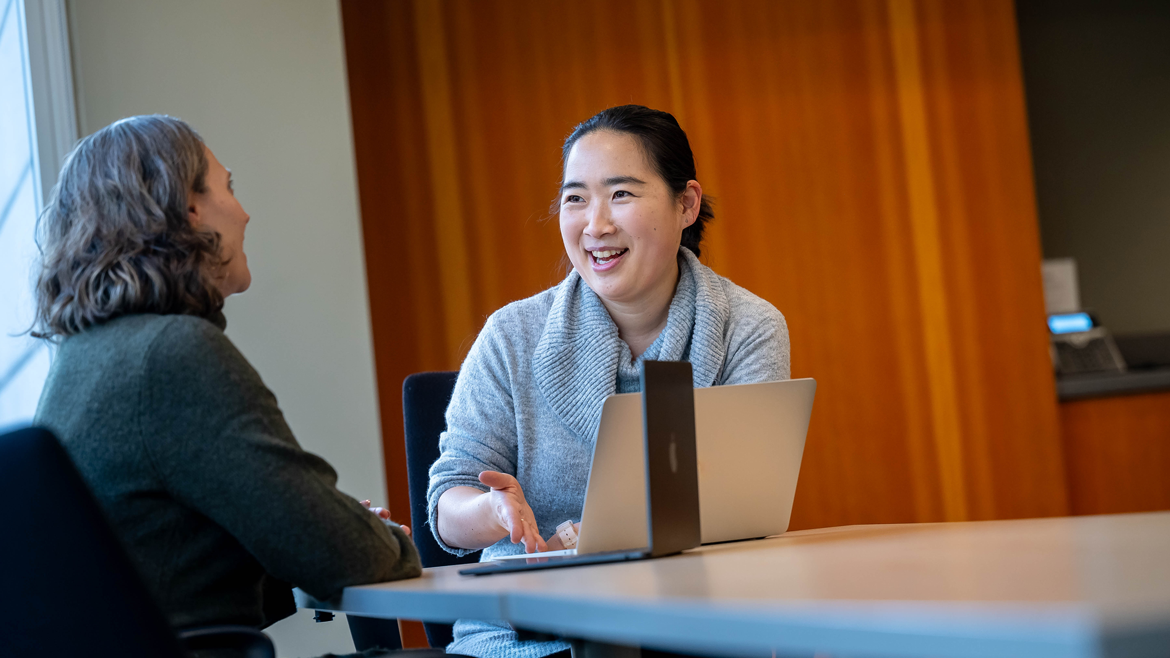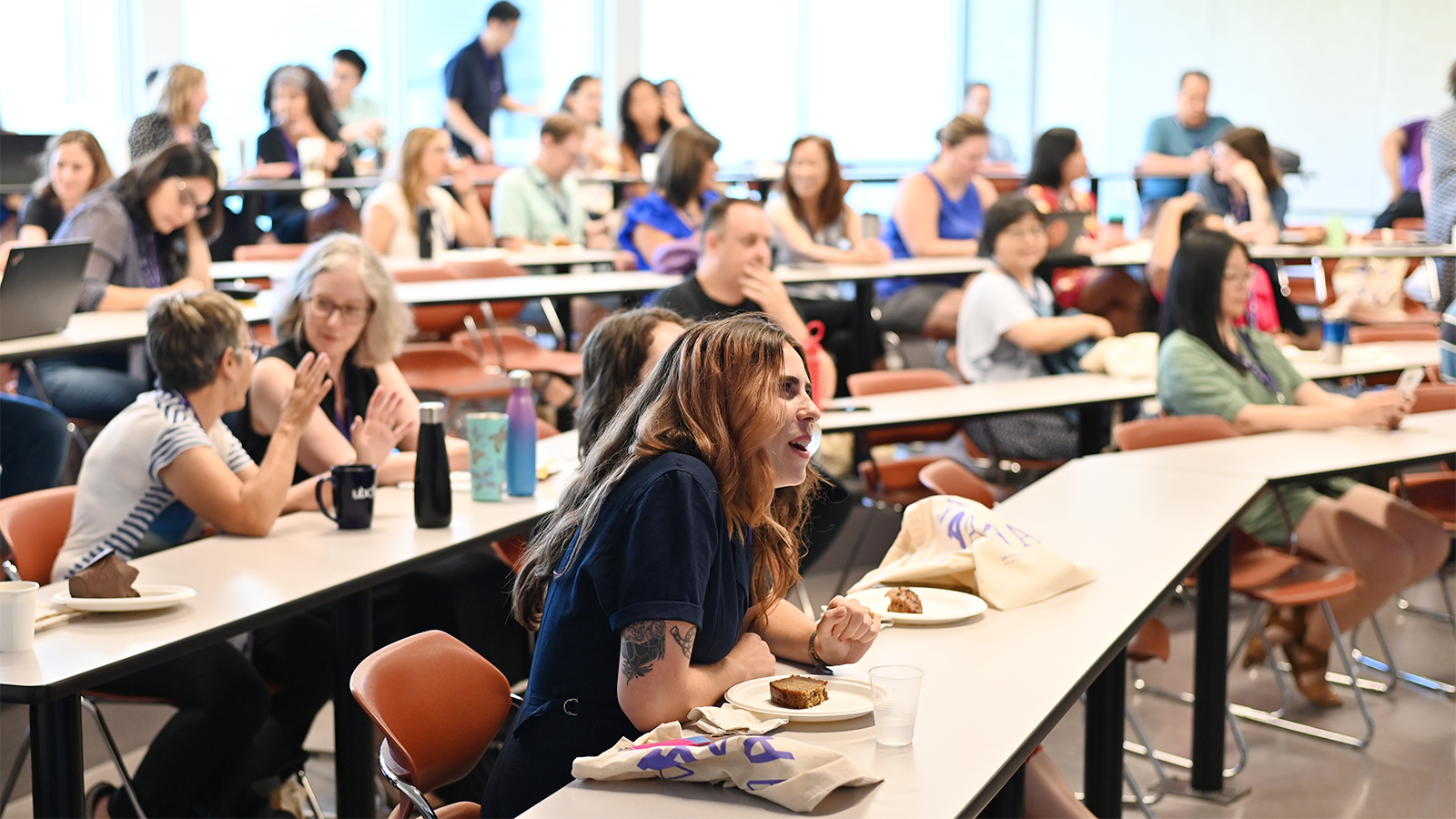

Dr. Gisèle Baxter, Sessional Lecturer at the Department of English Language and Literatures
In ENGL 243: Speculative Fiction, students work in small groups of six or seven people over the course of the term to “construct” a synthetic human based on literary/cultural representations of synthetic humans in plausible near future settings.
While the students don’t literally construct their created beings, they work together to produce a collaborative written description of their synthetic human along with an in-class presentation that uses slides and apps for illustrative purposes. Groups must integrate relevant research into their project and are required to include a bibliography that includes 3-10 primary non-academic sources, 3-10 secondary academic sources, and 3-10 primary texts, including at least three of the course texts, used to provide ideas and inspiration.
“Through this course, I wanted students to get into the real-world arguments about ethics, risks, and benefits intrinsic to the notion of synthetic humans, and to see their approach to this group project in terms of its real-world reflections.”
The assignment, as part of ENGL 243, Speculative Fiction, provides an opportunity for students to explore the course’s concern with the literary/cultural representation of various synthetic humans through a collaborative project that is creative and enjoyable while still being pedagogically and academically grounded. The project provides a space for students to engage in collaborative exploration with their peers in a way that is integrated into the structure of the course, allowing for students to have an ongoing space for discussions around course material and material adjacent to it that they may be interested in.
- The project and group composition should be inclusive, so that no group is advantaged or disadvantaged by its members’ abilities, preferences, and resources and so that all groups are respectful environments, where everyone is a valuable member of the group, and no one is compelled to do something that makes them uncomfortable.
- The project should be pedagogically sound: to enable exploration of the course’s concern with the literary/cultural representation of various synthetic humans and to require academic work, including textual analysis and research (both primary and secondary).
- The project should be manageable, without taking up too much class time or too much of students’ time outside class.
- The project should be enjoyable, to allow exploration of those what-if, alternate-reality readings that so many of the texts invite and to allow imaginative engagement with the course’s central questions: what motivations might go into the development and construction of synthetic humans? What forms might such beings take?
Learning Activities
Prep Work
- Ahead of the term, create a detailed handout that provides all of the details of the project for students including: the motivation behind it, learning outcomes, connection with the course material, overall schedule outlining the different steps and expectations for the final report and presentation.
- Create a survey aimed at understanding student preferences for working in a group to be administered to students at the beginning of the term and used to guide group formation. The survey is used to help make sure there is a balance in each group between students who are comfortable presenting and those more inclined to do the academic research aspects of the project.
- Create course material posted to Canvas that provides information about AI, robotics and genetic engineering to serve as idea generators for the students. Create and share resources in Canvas to provide information about different technical tools groups might use for developing the materials for their presentations.
- Plan into the course schedule class session time for groups to meet for planning and discussing project tasks with their groups. Set aside time during class once the groups have been announced so that group members can meet in person and introduce themselves.
Method
- Initiating the activity:
- At the start of the term, students complete a short survey to indicate their preferences for different aspects of the project. The instructor then uses the results from the survey to divide the students into groups of 6 or 7.
- Once the groups have been established, the instructor creates a discussion space in Canvas for each of the groups to have an initial space for communication.
- Student groups meet during class to introduce themselves, begin discussing and planning their project work, and decide on how they will communicate. Starting at about midway through the term, students were given some time at the end of class once a week to work together on their projects.
- Feedback and facilitation:
- At different points, groups are required to check in with the instructor for accountability and feedback. One reporter from each group is asked to email the instructor to share their project idea and let the instructor know if they are having difficulty finding times to meet. Each student is also required to email the instructor regarding their own participation in the group.
- Throughout the term, the instructor monitors group processes to identify and resolve conflicts that arise due to group dynamics or other unavoidable or unforeseen problems. Although most conflicts can likely be resolved within the groups, some situations may arise where instructor intervention is needed or accommodations need to be granted due to external circumstances.
- Final presentation and report:
- Group presentations are scheduled across multiple class sessions at the end of the term. Groups are randomly selected to determine the order of the presentations.
- In addition to the presentation, student groups submit a formal final report to Canvas. As part of the final report, groups include a brief description of individual contributions to the group project, a bibliography of primary and secondary texts referenced and an overview of the project.
Grading
- In order to make sure the group project is pedagogically sound and worth a significant percentage of their grade, the weighting was set to 20% of the overall course grade, with all students in each group assigned the same grade. Since the activity was initially done as a pilot, it was graded generously and modifications to the grading may need to be done when the course is offered again.
- Ideas for improvement include rewriting the initial assignment document to clarify the roles and project stages in the initial description of the project, to emphasize how and why they are important, and to provide more guidance on collaboration strategies. A policy for conflict resolution in case issues with group dynamics need to be settled might also be included.
- Re-design the course schedule and content requirements to drop one of the course texts to allow more time in class to devote to group meetings.
- Start the process of conducting the survey and setting up groups earlier in the term so that students can begin working collaboratively earlier and mitigate some of the time challenges at the end of the term when they have multiple assignments due.
In which course did you use collaborative learning? What is the general nature of the course and how many students are generally in the course?
It is a second-year course aimed at a fairly general student body. Not all of our students are from Arts. I do get a certain number of Science students. They are in different disciplinary areas which are adjacent to the kind of questions that we are asking in the course, such psychology, psychiatry, medical science, engineering, history, and philosophy. About the course: Around 5 years ago I was part of a subcommittee set up by the Department of English Language and Literatures that was writing courses in areas of popular culture and was asked to write a prospectus for a course in Science Fiction and Fantasy. I felt that that I had enough opportunity to teach fantasy in other courses such as Children’s Literature and Victorian Literature, so this course needed to emphasize science fiction. Roughly at the same time, I was starting to give a series of conference papers on synthetic humans, and in that context of research I decided to focus this course narrowly on near future scenarios that draw on the research that we are doing now, such as research into Artificial Intelligence (AI), robotics, genetic engineering, genetic manipulation. ENGL 243 Speculative Fiction tends to attract students who are quite ardent about this material.
Why do you incorporate collaborative learning? What outcomes were you hoping to achieve?
I always have discussion forums on Canvas to permit more engagement with the class discussions and quite often people take a discussion prompt and respond directly to it. In this class, however, students were reading each other’s prompts; they would get into discussions and go off on a tangent. The class was showing a mutual interest,in the course material or at least in materials that are adjacent to it, so I thought they would probably enjoy an opportunity to pursue this kind of collaborative exploration with concrete motivation by having it as part of the project which would get them some credit in the course. The energy that they put into the discussion motivated me to implement this collaborative activity.
What was your role as the instructor in the process? What types of structure and support did you provide to students?
Even before the groups were established, I wanted the students to have a clear sense of what the project would be. I did two things ahead of time. First, I came up with a handout which provides details of the project: the motivation behind it, aims, learning outcomes, components, and connection with the course materials. The next thing I did was send them a survey where I asked them to identify, using a list of what would be involved in the project, what they are willing to do or absolutely unwilling to do. I wanted there to be enough to do in terms of research, design, and organisation that they would achieve pedagogical benefits and contribute something pedagogically sound. I tried to make sure that there was a balance between people who are perfectly comfortable with presenting and others who were not so sure about it. The toughest part was finding people who were interested in academic research component, as almost no student wanted to do that. Finally, I had to stress that being an intermediate-level literature course, it required academic research as a skill set, so that requirement would not be waived.
Then I set up the groups, keeping in mind that the group formation should allow a proper distribution of good presenters and people who may be shy about speaking up. I asked every student to email me regarding their individual participation in the group. I also asked one reporter from each group to email me and let me know if they were having difficulty finding time to meet and work together. Most of them were having difficulty with time, so starting right around midterm break I decided that at least once a week, and towards the end every day, they would have a set amount of time in class for working together.
I scheduled the presentation using the old draw of the hat, and prior to the presentations, the students were required to give me some sense of what they were working on, their focus area. In addition, they were required to submit a report providing a description and justification for the synthetic human that they were designing. It had to identify at least three of the course texts that served as inspiration, or at least that gave them ideas to work on. It also had to identify some secondary research materials that they consulted, which could be academic material or non-academic material.
On Canvas I have links to information about AI, robotics, genetic engineering, and so forth, in separate Pages in the General Resources Module, to provide idea generators for the students.
How did the activity work in terms of grading and feedback?
I wanted this to be pedagogically sound and worth a significant percentage of their grade, so I decided to make it worth 20%. However, it was a pilot project, so I marked it quite generously.
Required elements of the project included a brief description of individual contribution to the group project, a bibliography of primary and secondary texts (with a specific minimum number of academic sources required), plus an overview of the project. This work culminated in their presentations, and at the final stage in a coherent piece of writing in the form of a formal report including all the project elements identified here. The presentations and their accompany scripts were posted on Canvas after they took place (as this enabled the slides to be seen more clearly than on the classroom projector screen).
Throughout, I was available to address questions about approach and about the suitability of sources. The general marking standards used were the standards for undergraduate work identified on the website for the Department of English Language and Literatures.
What learning benefits have you seen?
Through this course, I wanted students to get into psychological and philosophical arguments about ethics, risks, and benefits, and to see this in terms of its real-world reflections and step outside the hallowed halls of academia. I also wanted to give them the opportunity of building connections. On the whole, I think that did happen: when the groups met in class, conversation was consistent, lively, and on topic. The presentations (and the synthetic humans) exceeded my expectations. I think students liked an opportunity to engage with literary/cultural texts in ways that invited consideration of real-world questions and concerns.
Reflection on the feedback
When designing this project, I was concerned about some issues, such a member of a group falling sick and personality conflicts within the group. If I were to run it again, I would have some sort of conflict resolution strategy in case any group implodes or at least some members of the group have difficulty working with each other. One of the big problems was that students were facing difficulty setting up times outside of class to work on the project, as many do not have a lot of free time to meet. I discovered they very much preferred meeting in person to using apps or the Canvas discussion forums.
What are some changes or improvements you wish to include in the future?
I think I would do an overhaul of the initial document, clarify the roles in the initial description of the project, provide more information about the various stages, emphasize how and why they are important, and probably also have a section on some collaboration strategies. I would also develop some kind of policy for conflict resolution in case group dynamics need to be settled.
There are two other key things that I would do differently if I were to set the project again. First of all, I would drop one of the course texts so that we would have more time to devote during class to group meetings. The other thing is that I would try to get the whole thing set up in the first week, requiring everyone then to read the handout and complete the survey, so that by the beginning of second week all the groups could start meeting and working collaboratively. (I would have to build in a strategy to address the tendency in the first few weeks for some students to drop and others to register late.)
Do you have any suggestions for instructors considering this type of collaborative learning activity for their course?
I think I would give them the same advice that I was given when I started teaching my own my own classes, which was to make use of your colleagues, talk to people who have done this sort of thing.
Figure out how to read your class as soon as possible in term, find out what they’re interested in, and get them to introduce themselves. Early in the term is also the shopping period where people are still deciding on the classes they want to register for and continue with, so you have new students coming in. For this, a system may be set up where students can introduce themselves on a rolling basis and you can find out about their familiarity with the course material, which, I think, would be very helpful in designing the project and forming the groups.
The introductions and group formations should be done much earlier in the term to enable students to get to know each other and start working together sooner rather than later.
Do you wish to share anything further?
I think it was a very valuable experience for the class on the whole and also for me because it gave me much greater confidence about the possibilities of collaborative learning, in terms of content, scenarios, the premises that students had to work up and the ways in which they needed to draw connections between those premises and the specific things that we were looking at in the course texts. I ended up learning about other disciplinary areas and the kinds of ethical questions they would ask (I very fondly remember the lively debates involving perspectives from psychology and philosophy), and about breakthroughs in genetic engineering and AI.
The best part of the project is that it opens up the possibility of a mutual learning experience both for the class and the instructor.
Special thanks to undergraduate academic assistant Alice Deng, who was invaluable in supporting the pilot of this activity.
Level of Difficulty: High (full term activity)
Course: ENGL 243, “Speculative Fiction”
Number of Students: up to 45
Expected Prep Time: 2 weeks (for integrating into an existing course)
Time: 1 full course length
Keywords: collaborative learning, multimodal student projects


